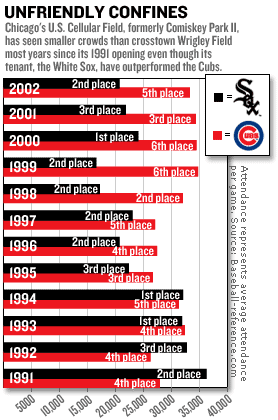
NEW YORK (CNN/Money) - U.S. Cellular Field in Chicago is a monument to the fat-cat luxury suite patron, designed first and foremost to separate fans as efficiently as possible from the greatest number of dollars.
And it is a wonderful testament to the fact this strategy is a money-losing one.
The home of baseball's Chicago White Sox, nee Comiskey Park II when it opened in 1991, is the site of this year's All-Star game. But the stadium itself has been no star. Of the 14 stadiums built since 1991, it is by far the least successful at attracting fans and revenue to what has been a modestly successful team.

The problem lies in the two tiers of luxury suites that push the upper deck into the stratosphere. What's more, the architects pushed the front row of the upper deck behind the luxury suites and lower deck in order to avoid any overhang over the more expensive seats below. These two design decisions make the game a rumor for anyone above about the sixth row of upper deck.
The stadium also suffers in comparison to one of the great meccas for baseball fans -- Wrigley Field, aka the Friendly Confines, home of the crosstown rival Chicago Cubs.
Wrigley, with its neighborhood park charm, its obstructed view seats, and relatively limited concession space, is a money machine for the team, a magnet for fans even during losing seasons. U.S. Cellular Field, with the warmth and charm of a suburban mall, almost seems to repel fans.
So since 1993, the Cubs, with about 12 percent fewer seats, have outdrawn the White Sox, even in years like 1993 and 2000 when the Sox finished first and the Cubs had their normal poor finish.
 |
|
| U.S. Cellular Field, formerly Comiskey Park II, has been criticized as having the charm and appeal of a shopping mall. |
White Sox spokesman Scott Reifert argues the team draws better in its new park than in the old stadium that had been across the street.
"The 2000 attendance was the seventh best in club history," he said. "I don't know if it's anything that anyone has to apologize for."
He also points out the team has made a number of renovations and plans further changes, such as brick work and lighting to improve the warmth and feel for fans. But while plans have yet to be announced, taking out a level of luxury suites and lowering the upper deck probably isn't in the works.
It's a wonderful thing, for those who like to see underdogs rise up and bite the fat cats, that the team is out far more money from lost ticket sales since the new park opened than it could ever bring in from all its luxury suites.
| SportsBiz
|

|
| Click here for SI.com sports coverage
|
|
|
|
The 102 completed suites bring in less than $10 million in rent a year. But the team hasn't sold all the suites on a full-season basis as in many stadiums, and hasn't even completed outfitting all the suites it originally built. Overflow press at the All Star game will fill some of those suites.
If the White Sox had been able to raise their attendance to a modest 80 percent of capacity, with each extra ticket bringing in only an average of $12, less than the cost of a current upper deck seat, the additional ticket sales would have been worth between $11 million and $18.5 million a year since 1995.
No one is suggesting building a park with no luxury boxes in the current sports business environment. But suites can be added without tipping the balance so totally against the lower-paying fans. And by keeping a better balance, the team can keep a better revenue flow.
| Related columns
|

|
|
|
|
Other new parks -- such as Camden Yards in Baltimore, Jacobs Field in Cleveland, PacBell in San Francisco, and Safeco in Seattle -- all went with more intimate designs that made their lower-paying fans feel like customers, not mountain climbers.
That group of four parks has sold out better than 90 percent of their tickets three years out of four since their openings. The White Sox have never sold better than 74 percent of the seats in a season since 1992, and have averaged only 55 percent of seats overall. When the sellout crowd attends Tuesday's All-Star game, it will be only the fifth time this season they've filled more than two-thirds of the seats -- the three games against the Cubs and the good but not sellout crowd for opening day were the only others.
White Sox owners, who chose this type of park over the more fan-friendly model in a misguided attempt to grab the big bucks, have no one to blame but themselves for the problem that will dog their box office revenue for years to come.

|

